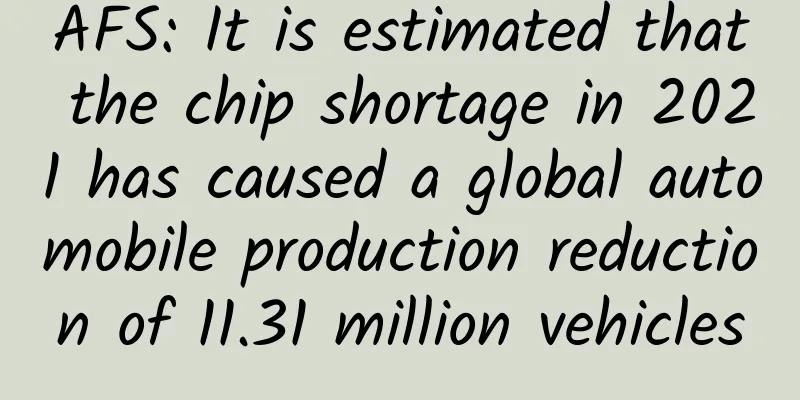AFS: It is estimated that the chip shortage in 2021 has caused a global automobile production reduction of 11.31 million vehicles

|
According to the latest data from AutoForecast Solutions (AFS), as of December 19, the global automobile production has been reduced by 10.272 million vehicles due to the shortage of automotive chips, and the global production is expected to be reduced by 11.31 million vehicles in 2021. Among them, the cumulative production reduction in the Chinese market is 1.982 million vehicles, and the annual production reduction is expected to be 2.148 million vehicles this year. In other markets, North America has reduced production by 3.178 million vehicles, and is expected to reduce production by 3.412 million vehicles this year; Europe has reduced production by 2.954 million vehicles, and is expected to reduce production by 3.349 million vehicles this year. In other Asian regions excluding China, production has been reduced by 1.74 million vehicles, and is expected to reduce production by 1.952 million vehicles this year. As an important link in the global semiconductor industry chain, the future trend of the epidemic in Southeast Asia will still have a crucial impact on the security of the chip supply chain. Cui Dongshu said that the back-end packaging and testing work is mainly concentrated in China, Japan, South Korea and Southeast Asian countries. Some of these countries have extremely low vaccination rates and high risks of repeated epidemics, and the back-end packaging and testing process still faces challenges. However, as the epidemic in Southeast Asia gradually improves, the automotive chip supply chain is recovering faster, and the chip shortage is easing. Cui Dongshu, secretary-general of the China Passenger Car Association, said: "The darkest moment for chip supply in the passenger car market has passed." Even so, with the increasing electrification and intelligence of automobiles, it will be difficult to achieve a balance between supply and demand of automotive chips in the short term. Chen Shihua, deputy secretary-general of the China Association of Automobile Manufacturers, said that although the current chip supply has eased compared to the third quarter, there is still an obvious shortage of some chips. For example, at the Muar factory in Malaysia, although production capacity has been restored, the factory is fully committed to producing ESP chips that were in short supply in the early stage, resulting in a shortage of door controller chips and iBooster control chips also produced by the factory. In addition, the fourth quarter is traditionally the peak season for automobile sales. On the one hand, each OEM needs to increase production to meet market demand, and on the other hand, they need to prepare for the first quarter of next year, which invisibly increases the market demand for automotive chips. Chen Shihua believes that "the shortage trend will continue for some time, possibly until the second half of 2022." Ziji Micro Network |
<<: The next wave of entertainment: Changhong naked-eye 3D TV mobile phone
>>: Speedcheck: 35.2% of Americans say their devices don't support 5G
Recommend
pua popular explanation, what is PUA?
pua popular explanation, what is PUA? PUA origina...
Using data to interpret "Ode to Joy 2" from all angles
As a data analysis enthusiast, the author of this...
IBM cognitive white paper: The path to intelligence
When the term artificial intelligence was first c...
Is parking and charging difficult? SAIC New Energy provides free services at Hongqiao Hub!
Recently, in response to the parking difficulties...
Drainage methods for medical beauty dental clinics!
Words written in front: A few days ago, in the Q&...
Children have a fever, can rubbing alcohol reduce the fever? Don't, these fever-reducing methods may be fatal
gossip "Children with fever can be treated w...
3 mind maps to help you learn how to plan and operate community programs!
This is a simple mind map of paid community plann...
The full-screen iPhone is getting closer to you, but Steve Jobs' Apple is getting farther and farther away from you
The decline of Apple’s mobile phone business show...
The last source of animal protein for humans! The quantity is as high as hundreds of millions of tons, why hasn’t it become a national delicacy?
Expert of this article: Liu Yadan, former assista...
Jump to Taobao as soon as you click it? These animals can jump faster than Taobao!
During this Double Eleven, did you also experienc...
People stranded in Hubei will undergo double nucleic acid testing when returning to Beijing, and safety work still needs to be done!
Beijing News Express (Reporter Sha Xueliang) On t...
Stay! New species are lurking around us
Seaside Lycoris Picture Bai Yu Baohua Old Crow Pe...
Five years of practical operation experience, revealing seven golden rules of user operation!
Preface User operation is the most important part...
Apple Pay: Apple's payment ambitions
This time, money was directly used and Jobs was n...
WeChat official announcement: Mini Program regular review is suspended during the Spring Festival and will resume on February 7
As the Spring Festival approaches, many companies...









